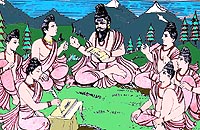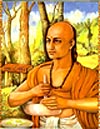|
Ayurveda is an ancient
system of natural & medical healing originated in
India. Ayur means life and Veda means Science. Thus
Ayurveda means science of life. It gives a total approach
to health, healing and Longevity. The holistic system
of medicine is supposed to be the oldest form of health
care system available on planet today. It is believed
that other healing systems were influenced by the knowledge
of Ayurveda.
The
unique system of healing believes is not only treating
the ailments of body alone but also the mind and spirit.
The most amazing part of ayurveda is that it uses almost
all methods of healing like yoga, meditation, purification,
regime, astrology, and incorporates herbs, gems, colour,
massages, diet, exercise etc, which can be individually
used to heal a number of ailments in a suffering person.
According
to Ayurveda everything in nature -the body, foods, season
etc are all composed of five elements originally called
panchmahabhuts. These are Earth, water, Fire, Air &
Space. Practioners or Vaidyas group these five elements
into three categories called Doshas. These are Vata,
Pitta and Kapha. They believe that an imbalance in these
doshas causes illness. Ayurveda believes is treating
the sick and restoring the health of a healthy person.
 |
The
ancient wisdom of healing system was a part of
spiritual tradition of Vedic religion. Dhanwanthari
moorthy is considered as the god of Ayurveda.
Originally four main books of spirituality, which
covers a vast number of subjects from astrology,
health, business etc are written in Sanskrit and
are known as Vedas. These Vedas belongs to approximately
2500 B.C or earlier and known as oldest writing
in the world. They are 1] Rigveda 2] Yajurveda
3] Samaveda and 4] Atharva Veda. |
During
3000 to 2000 B.C Atharva Veda was written of which Ayurveda
is upaveda [Sub-section]. This was first time the traditionally
practiced oral form of ayvrveda was written in a text
form as an independent service.
Atharva
veda lists eight divisions of ayurveda. These are Kayachikitsa
(Internal medicine), Shalakyachikitsa(surgery
of head, neck ophthalmology (ornithology), Shalayachikista(Surgery),
Agadtantra (toxicology), Bhootvidya(psychiatry),Kaumaryabhrityatantra(paediatrics),
Rasayan(Gerontology or science of rejuvenation)
and Vajikaran(science of fertility).
The oldest treastise available on this version is Atreya
Samhita.
Around
1500 B.C two school of thoughts existed and those made
Ayurveda a scientifically verifiable and classified
medical system.
1] Atreya-: The School of Physicians.
2]
Dhanwantari-: The School of Surgery.
Both
school thoughts had their own philosophy, diagnostic
patterns, treatments and medicine. They had different
followers and the texts were written by the school accordingly.

Ancient
Ayurvedic School of Thoughts
|
The
texts are divided into two major categories namely
1] Brihat trayi 2] Laghu
trayi.
Brihattrayi includes Charaka Samhita,
Sushrut Samhita and Ashtanga Hridayam.
Laghutrayi includes Sharangdhar
Samhita, Bhavpakash and Madharnidam.
|
These
text describes the basic principles and theories from
which ayurveda has evolved. They also include vast clinical
information of many diseases and their management.
 |
Charaka
is one of the most well known physician of ancient
times. Charaka Samhita followed the Atreya School
of thought and explains the logics and philosophy
on which the system of medicine is based. Most
of Charaka Samhita is in the form of meeting where
Scholars taken into consideration before comes
to conclusion. Thus ayurveda is a result of constant
verification and authentication by a group of
learned physicians. |
Pinda
Bramhanda Nyay:
According
to the law of microcosm and macrocosm every thing that
exist in the vast external universe or the macrocosm,
also appears in the internal cosmos of the human body
or the micro cosm. This in Sanskrit is known as the
' Pinda Bramhanda Nyay'. It is believed that the microcosmic
body when healthy is self-perpetuating and self-correcting.
Pancha
Mahabhuta(The five elements)
All
the matters in the universe is made up of five elements
such as Earth, Water, Fire, wind and space or void or
ether. Earth represents the solid heavy state; water
represents the free flowing liquid state. Fire represents
a substance's ability to undergo change, wind represents
the gaseous state, void or ether is space, which encompassed
the matter.
Samaan
Viparita Nyay.
Since
body is also an object, it is also made up of five elements.
The health is preserved only when these five elements
comprising our body are in homogeneous state and equilibrium.
Our food and life style has impact on this delicate
balance of five elements. However these foodstuffs and
lifestyles have three types of effects on the body.
1]
It can act as food and nourish the body.
2] It can act as medicine and bring about balance in
the elements.
3] or it can act as poison and disturb on the body functions.
Guna(Qualities)
Any
substance ranging from fruits, vegetables, meat, grains,
herbs, minerals etc are carriers of number of qualities.
Some of the qualities of substance are very innate and
cannot be segregated where as in others it can be changed
by processing the substance.
Ayurveda lists ten pairs of qualities which are opposite
to each other in nature. They are heavy&light, Slow
acting and fast acting, cold and hot, Greasy and moist
and dry, smooth and rough, viscous and clean, soft and
hard, stable and mobile, subtle and gross, Sticky and
non sticky.
Tridosha
[Three functional Elements]
Three
dosha activates all five elements in the human body.
Five elements in the cosmic universe have their counterparts
encompassed in tridoshas in the body. The work dosha
is derived from the Sanskrit root 'dosh' meaning to
corrupt. This dosha corrupts the tissue and the waste
products in the body, which leads to diseases. However
disease occurs only when there is an unibalance in those
three doshas , where as in equilibrium they help to
bring about all physical activities and chemical changes
taking place in the body via digestion, assimilation,
circulation, metabolism etc. These three dosha are vata,
pitta and Kapha.
Vata is predominantly made up of air
and ether elements, where as pitta
is made mainly of fire while the Kapha
has earth and water as its primary elements.
Dhatus:
The three doshas displays their activity by acting through
the tissues and the waste products that makes up the
body. The food and water that we consume undergo chemical
changes and produce seven tissues that are known as
dhatus.
|